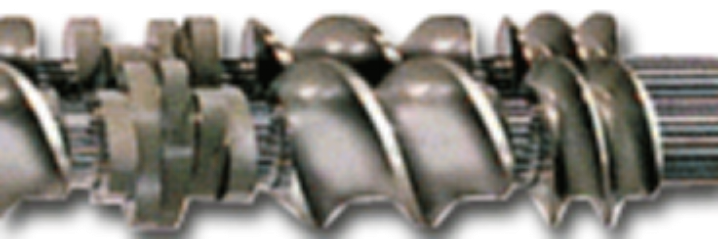What are the common new types of screws for extruders?
We all know that the heart of the extruder is the screw, the most commonly configured is the conventional full-thread three-stage screw, but the conventional full-thread three-stage screw has its shortcomings, such as low solid conveying capacity in the feeding section; There are solid bed and molten pool in the groove of the compression section, the melting efficiency is low, and the pressure, extrusion rate and temperature fluctuate greatly. The homogenization section still has the function of melting solid material, and has little effect on the mixing of filler and coloring material. Because there are some shortcomings of the conventional full-thread three-stage screw, the new type screw is also used. Today, Today, I will tell you about the common new screw.
1. Classification of new screw
Common new types of screws mainly include separation type screws, barrier type screws, split type screws, and combined screws.
1.1 Separation type screws
The principle of the separation type screw: separate the melted material from the solid bed as soon as possible with the secondary thread, promote the faster melting of the unmelted material, and reduce the shear of the melted material, so as to realize the extrusion at lower temperature and ensure the quality of plasticization. Increase the extrusion volume under the premise.
Separate screw structure: Different from the conventional screw, a secondary thread is set at the end of the feeding section, and its major diameter is 2G smaller than the main thread. The beginning of the secondary thread intersects the main thread, and the lift is different from the main thread.
Separate screw characteristics: uniform extrudate; high production capacity, low power consumption; good exhaust performance; small extrusion rate and temperature fluctuations, and good plasticization quality.

Structural schematic diagram of separation type screws
1-Solid phase slot 2-Liquid tank 3-The main thread 4-Secondary thread
1.2 Barrier type screws
Structure: a barrier section is set up somewhere in the screw to prevent unmelted solid particles from passing through and to promote the melting of a new type of screw.
1.3 Split type screws
Structure: A new type of screw that is equipped with a flow divider element (such as pins, grooves or holes, etc.) on a certain section of the conventional screw to change the flow state, promote melting, and enhance the effect of mixing and homogenization.
1.4 combined screws
Structure: Various functional elements (conveying, compressing, shearing, mixing, homogenizing, etc.) are made into a building block structure, which can be combined into a complete screw according to different process requirements.

2. Precautions for new screw design and selection
It is necessary to clarify the working principles and applicable occasions of various new types of screws.
Choose the ideal mixing element and shear element location.
The melting capacity of the screw must match the metering (homogenization) capacity and the conveying capacity.
The above is part of the introduction to the new types of screws for extruders. If you have anything you don’t understand or want to know more about plastic machinery and equipment, please contact me. My name is Luna, my email address is luna@lantaimachinery.com, WhatsApp/Wechat: + 8613519648306.



